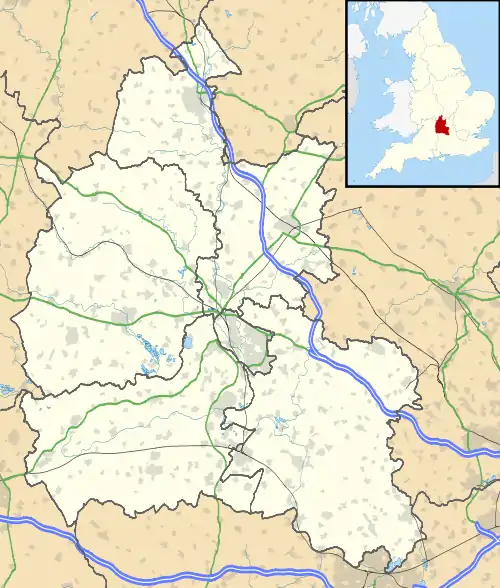| Old Town Hall, Faringdon | |
|---|---|
 Old Town Hall, Faringdon | |
| Location | Market Place, Faringdon |
| Coordinates | 51°39′30″N 1°35′02″W / 51.6583°N 1.5839°W |
| Built | 1650–1660 |
| Architectural style(s) | Neoclassical style |
Listed Building – Grade II* | |
| Official name | Old Town Hall |
| Designated | 12 February 1958 |
| Reference no. | 1048440 |
 Shown in Oxfordshire | |
The Old Town Hall is a municipal building in the Market Place in Faringdon, Oxfordshire, England. The building, which is used as an exhibitions and events venue, is a Grade II* listed building.[1]
History
Following the Battle of Faringdon in 1645, a skirmish in the English Civil War at which many of the town's buildings were damaged or destroyed by the attacking roundhead forces, civic officials decided to build a new market hall.[2] The new building was designed in the neoclassical style, built using timber frame construction techniques with a stucco finish and was completed by 1660.[2] The ground floor was arcaded, so that butter markets could be held, with an assembly hall on the first floor. On the ground floor, there were twelve Tuscan order columns,[3] while the first floor was fenestrated by two sash windows on each of the east and west sides and by a single sash window on the south side. Above, there was a modillioned cornice surmounted by a hipped roof with a weather vane.[1] The architectural historian, Nikolaus Pevsner, described the building as "smaller and more provincial" than the other town halls in the area.[4]
A metal hoop was attached to the southwest column to bind petty criminals for whipping and a lock-up was established in the north east corner for incarcerating them.[2] In the 19th century, an extension was built to the west to accommodate a larger lock-up.[5] After a police station, with proper cells, was established in Swan Lane in the 1880s, the western extension was converted to accommodate the equipment used by the local street sweeper.[5] By the mid-19th century, the assembly room was being used as a public reading room[6] but by the 1880s it was not used at all.[7] The local horse-drawn fire engine, which had been stored in Church Street, was moved to the ground floor of the town hall in the early 20th century.[5]
In 1918, the lord of the manor, Lord Berners of Faringdon House, who had recently inherited the town hall along with the estate and, with it, a significant liability for backlog maintenance on the town hall, decided to give the building to the town.[5] May Morris of Kelmscott Manor led a successful campaign to refurbish the building and to install a series of oak panels on the south side of the building to commemorate the lives of local service personnel who had died in the First World War.[2] The oak panels were unveiled by Lord Faringdon on 6 February 1921.[8][9]
During the Second World War, the assembly hall was used as sleeping accommodation for officers of the armed services and after the war it was used as a public library.[1] After the library service moved to The Elms in Gloucester Street in the late 1980s, the assembly room became a Red Cross charity shop.[5] A new staircase was installed, and the assembly room was converted for use as an exhibition and events space in 2000.[5] Fabrics designed by William Morris were used in later refurbishment work to honour the work of his daughter, May, in saving the building.[10] The assembly room was also subsequently used for as a venue for parish meetings.[11]
See also
References
- 1 2 3 Historic England. "Old Town Hall (1048440)". National Heritage List for England. Retrieved 30 March 2022.
- 1 2 3 4 "Faringdon History Walk" (PDF). Faringdon and District Archaeological and Historical Society. p. 3. Retrieved 30 March 2022.
- ↑ Clarke, Peter (2002). Small Towns in Early Modern Europe. Cambridge University Press. p. 130. ISBN 978-0521893749.
- ↑ Pevsner, Nikolaus (1966). Berkshire (Buildings of England Series). Yale University Press. p. 34. ISBN 978-0300095821.
- 1 2 3 4 5 6 Church, Rosemary (2017). "The Market Hall". Faringdon and District Archaeological and Historical Society. Retrieved 30 March 2022.
- ↑ Directory & Gazetteer of the counties of Oxon, Berks & Bucks. Dutton, Allen and Co. 1863. p. 267.
- ↑ "Kelly's directory of Berkshire, Bucks and Oxon". 1883. p. 53.
- ↑ "Faringdon War Memorial". Faringdon Town Council. Retrieved 30 March 2022.
- ↑ "Faringdon". Imperial War Museum. Retrieved 30 March 2022.
- ↑ "The Old Town Hall". Focus on Faringdon 2013/2014. p. 4. Retrieved 30 March 2022.
- ↑ "Faringdon Old Town Hall 'on stilts' to get major repairs". Oxford Mail. 24 October 2018. Retrieved 30 March 2022.